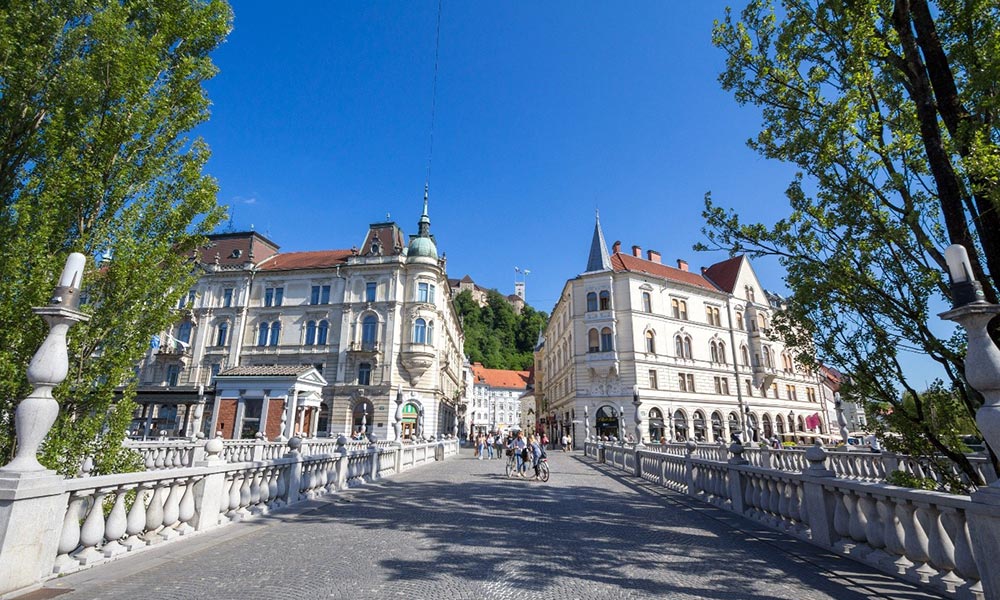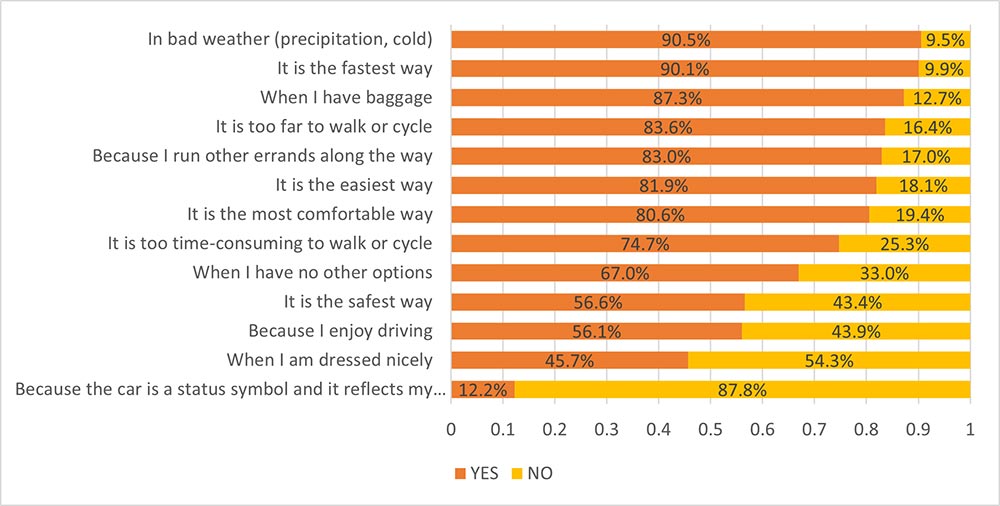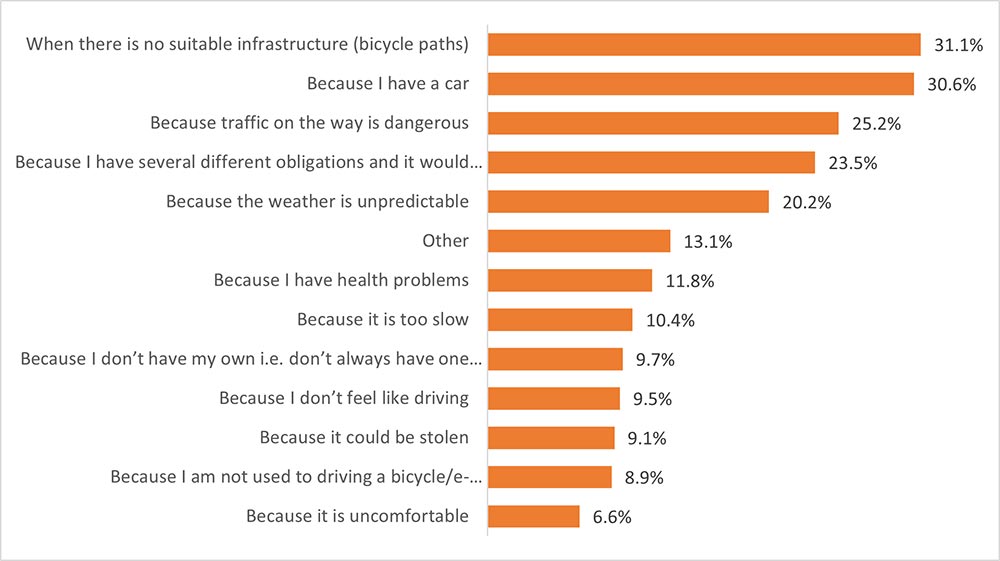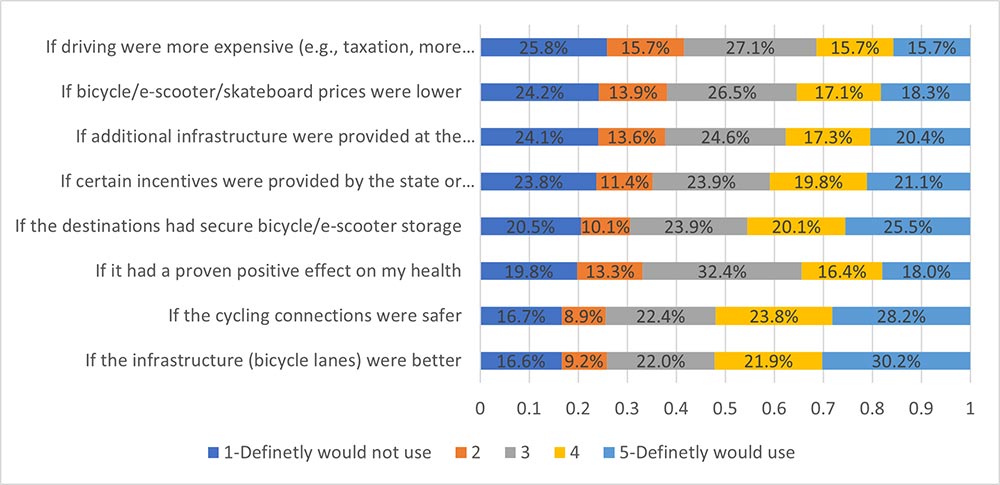
In a recent study, the Slovenian IPoP - Institute for Spatial Policies investigated why Slovenians choose certain modes of transport over others to run their daily errands. The study particularly looked at short-distance journeys of up to five kilometres, which have the greatest potential to replace car trips.
Read the entire study here (in Slovenian language).
Data of the Slovenian statistical office shows that most of the daily journeys to school, work, and run errands are still made by car, even for distances up to five kilometres. More than 50 % of daily trips made by car are under 2 km and a fifth of people use their car for journeys of up to one kilometre. Personal vehicle use accounts for a large share of greenhouse gas emissions and the numbers keep going up. Enabling more walking and cycling on daily short-distance journeys would have a significant impact on reducing greenhouse emissions, as well as on our health and sustainable development.
In response to these developments, IPoP developed campaigns to encourage active mobility. Active mobility, which includes walking, cycling and electric scooters, is the ideal solution for distances under five kilometres. The campaign first looked at what drives people to develop certain mobility habits. Why do they choose to drive to work or school when the distance could easily be walked or cycled? And under which circumstances would they be willing to change their habits?
In an online survey by Ninamedia in 2020, IPop looked at the travel behaviour of 2,859 respondents over the age of 15. The survey will be repeated in 2022, 2024 and 2026.
The survey is part of the Life IP Care4cimate project, in which IPoP will create and implement six campaigns with goal of encouraging Slovenians to make more of their daily journeys on foot or by bicycle.
The study revealed that when it comes to choosing a daily mode of transport, the respondents think practically, not ideologically. Most do not choose to use a car for short distances because they believe the car reflects their lifestyle or that it gives them a certain reputation and status. Even so, 56.1% of those that most often take the car do so because they enjoy the ride.
The greatest share of respondents who most often use a car for their daily journeys use it in bad weather (90.5%) or because it is the fastest travel mode (90.1%).
A large share uses it because they believe this choice to be the easiest (81.9%) and most comfortable way to travel (80.6%). Or they choose to use a car when they have baggage (87.3%) or because they run other errands on the way (83%). Most regard the distances to be too great (83.6%) or too time-consuming (74.7%) for walking or cycling.

The survey also examined why the respondents did not use other types of active mobility. Some of the most common reasons the respondents listed as obstacles to walking and cycling are the lack of suitable infrastructure, i.e., bicycle lanes (31.1%), dangerous traffic situations (25.2%), several different obligations (23.5%), and unpredictable weather conditions (20.2%).
Almost a third of the respondents answered that the reason they did not opt for other modes of transport is because they own a car (30.6%), which confirms the role of the car as being the primary mode of transport. This is a population group that owns their own car and makes practically every journey with it without even thinking about other possibilities.

Rain has the biggest influence on the respondent's mobility decision. As many as 72.7% of the respondents mentioned rainfall as the deciding factor for them not to opt for active mobility. Low temperatures also have a profound or very profound impact on this decision for 53% of the respondents, while high temperatures are important or very important factors for only 19.2% of the respondents.
This shows that people have not yet internalised severe urban overheating as the consequence of global warming and therefore do not perceive heat to be as bothersome as rain.
The study also examined under what conditions the respondents would be willing to swap their car for walking, cycling, or other means of transport.
If the infrastructure (bicycle lanes) was better, 52.1% of the respondents would choose the bicycle or other similar mode of transport over the car, while 52% stated that they would opt for it if cycling connections were safer. Moreover, 45.6% would use their bike if they had access to safe parking facilities at their destination.
Incentives by the state and employers, additional facilities for cyclists at the destination such as lockers and shower in the workplace, and lower prices of bicycles and other similar modes of transport bear somewhat less potential for change. About a third of the respondents would be willing to swap their car for a bicycle if this had a proven effect on their health. Of all the options, financial sanctions, such as car transport being more expensive through taxation and higher parking prices, have the least potential to enable change.

The most powerful motivation for swapping the car for walking is traffic congestion, in which case 58.1% of the respondents would decide to walk. This confirms the assumption that the car is still comfortable enough, and congestion does not yet deter people from using a car.
57.3% of the respondents would choose to walk if they had health problems or if they were advised to move more. 46.7% would choose to walk if this had a proven beneficial impact on their health.
Over half (50.3%) of the respondents would choose to walk instead of drive if safe and comfortable walking conditions were ensured, such as wide pavements, raised crosswalks, and trees offering shade.
Similar to the idea of swapping a car for a bike, the weakest motive for swapping the car for walking is more expensive car transportation, as only 37.6 % of the respondents would opt to walk in that case.
The survey results indicate that using the car for most daily journeys is still attractive because the respondents regard it as simpler, more comfortable, and faster compared to active mobility.
The respondents state that the infrastructure for walking, cycling, or other forms of active mobility is lacking or at least not appealing enough. Considering the recent investments in cycling infrastructure in most Slovenian municipalities, this is somewhat surprising. Several hundreds of kilometres of new cycling or walking routes are planned for the future. The impact of these investments on travel habits will most likely be seen in the coming years, wherein the soft measures should not be neglected. Perhaps the respondents should be better informed about the improved cycling options, as they may not even be aware of them.
The respondents also see the facilities of their daily goals as obstacles to active mobility.
Workplaces and educational institutions should be better equipped with lockers and suitable areas for bicycle and other similar transport vehicle storage. The issue then is taking into account daily mobility in spatial planning and construction projects, as well as normalising arriving by bicycle or on foot.
To a certain extent, financial measures, such as incentives or sanctions, could contribute to changes in mobility habits, as their potential for change was confirmed by about a third of the respondents both for walking as well as cycling.
In light of the respondents' answers as to the conditions that are necessary for changes to their travel habits, creating campaigns will need to place a lot of attention on the practical aspects. How to organize daily journeys so that most can be done on foot or by bicycle, how to be equipped for different weather conditions, and how to organize luggage transport in the future?
Health has also proven to be a strong motive; however, some effort is still needed for raising awareness on the impact of daily movement, which most people would find easiest to do precisely by changing their travel habits.
In shaping future activities, we will focus on:
The study How people choose the mode of travel? is an activity in LIFE IP CARE4CLIMATE (LIFE17 IPC/SI/000007), an integral project co-financed by funds from the European LIFE project, funds from the Climate Change Fund, and funds from the project partners.